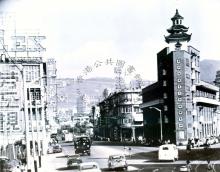Typhoon November 9th-10th 1900
Primary tabs
41. The following is a copy of the report on the damaging typhoon which occurred on the night of November 9th-10th :
Report on the damages to Government property and buildings due to the Typhoon which passed over Hongkong on the night of the 9th and morning of the 10th November 1900
This report deals only with damage done to roads, works and buildings in charge of the Public Works Department. The typhoon, which had been signalled for two days, seems to have rapidly approached the Colony during the night of the 9th and to have acquired damaging intensity and force about 2 a.m. on the 10th, apparently reaching a climax between 5 and 6 a.m. when the rapid veering of the wind from North and North-West to West caused the greatest damage.
Roads:—The force of the wind raised a very heavy sea in the harbour which (especially in the West) broke over the Praya Wall scouring away the surface and in some instances forming deep pits in the roadway. Owing to the Praya Wall resting on it rubble mound, the earth filling gets drawn out from under the road surface and subsidences such as described take place.
The heavy rainfall which accompanied the storm brought down much debris and silt from the hill sides, obstructing the side and cross drainage, and so causing damage to the road surfaces. The roads in Kowloon suffered much in this way, and the road into the New Territory slightly.
The damage was in no case so extensive as to stop the traffic. The repairs are being carried out as rapidly as possible, and will entail an expenditure of about $1,000.
Buildings (Permanent):- Every public building in the Colony suffered more or less, tiles and guttering and downpipes were torn from the roofs, causing leakage which damaged the ceilings and plastering; jalousies were smashed and the hinges and fastenings twisted and broken, while the destruction of glass was considerable in the eases where the shutters or jalousies gave way. The sun blinds of the Government Civil Hospital were destroyed and will cost $250 to replace. The cost of repairs to Government buildings will be about $2,000 and can be borne on the Estimate for Maintenance, (annually recurrent).
Buildings (Temporary):- Temporary matshed buildings were destroyed everywhere, the principal being the official matsheds at Tai-po which would cost about $1,500 to replace; the Government bungalow at the same place was badly damaged; the Police matshed at Sha-tin occupied by the Indian Police; the Assistant Engineer’s bungalow and out-buildings at Tai Wai which cost upwards of $1,000; the Kanpuishek Customs Station occupied by the Temporary Surveyor and his family, and an Overseer; the plague sheds at the Kennedy Town Hospital, which will cost $850 to replace; and the sheds lately erected on the top of Green Island in connection with the new Signal Station.
If all these temporary buildings had to be replaced, the cost would not he less than $8,000 to $10,000, but some can be dispensed with until permanent buildings take their place, so that the expenditure on this account in restoring buildings absolutely necessary will probably not exceed $3,000.
Telephones.— The Government telephone lines were much damaged, both iron and wooden posts being thrown down, the wires blown down, twisted, and broken so that they could not be again utilized, the estimated cost of fully restoring the Government lines is $700.
Government Piers.—Very trifling damage was done to the Government Piers in Hongkong Harbour, except the timber pier at Sam-shuipo which was worn out and condemned and about to be replaced by a new pier. This was completely destroyed. The temporary pier used by the Harbour Master was carried away and an iron ladder connected with it. As a new pier for Sam-shuipo has been already sanctioned and provided for in the Estimates no special expenditure on this account is rendered necessary.
Lighthouses.—At Gap Rook the Derrick Crane lately renewed was broken and 12 counterpoint weights lost, the winding gear was damaged, and the telegraph wire broken, also one stay and halyards carried away from the flagstaff and sundry other damage done to the doors and windows of the buildings, all of which it will cost about $1,500 to restore.
Miscellaneous: - The yard of the signalling flagstaff at Tsim Sha Tsui was smashed and is being replaced by the Dock Company, -$170.
The turfed slope in front of the Belilios Reformatory was washed away and damaged to the extent of about $200.
On the whole, considering the severity of the storm, the damage caused was not great
Source: 1900 PWD Report
- Typhoon November 9th-10th 1900 appears on Timeline Typhoons in Hong Kong


Comments
Typhoon of 9-10 November, 1900
On the occasion of the 1906 typhoon, Sir Henry Blake telegraphed from Kandy, Ceylon:
"I desire to express deep sympathy with the people of Hong Kong repeating the disaster of 1900."
Sir Henry's summer house was badly damaged in the late typhoon of 1900 and the Peak houses were badly hit, but the loss of life and the general destruction seems to have been much less. The press coverage of the 1900 typhoon is much slighter as well as the concern as to the number of the local Chinese who might have drowned. The contrast with 1906 is very marked as far as the energy put into saving lives and also retrieving the dead from the water was concerned.